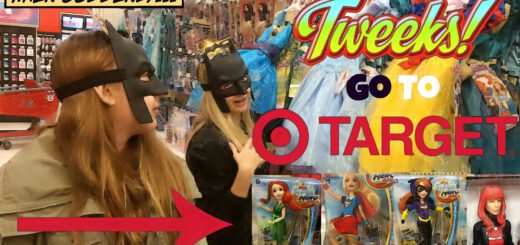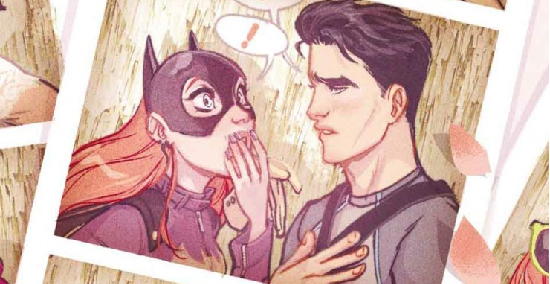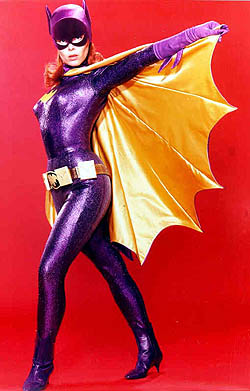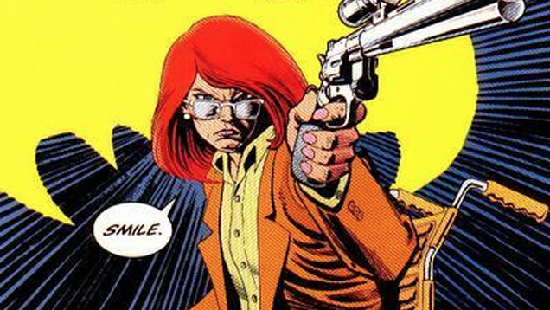Fair warning: this one is long and a bit sappy. I would, however consider it a personal favor if you would give it a read and send me a hug.
I need one.
OK, another version of this article will be appearing on Bleeding Cool but this is the Mike Gold special edition, chock full of what’s not in the BC article.
A week or so ago I was writing the fuck you article to beat all fuck you articles. You would think with the year I’m having, I’d be ranting away all the time but somehow that’s not been my aspiration. Nope. Some how I’ve avoided ranting anywhere but on Facebook. I don’t have a lot of Facebook friends as I choose to police my page like Ferguson P.D. so anyone I don’t know, I shoot down their friend request like a unarmed black kid.
Even there, I’m not as rant crazy as I was once. Lately I’ve just been sad, very sad and no one wants to read that so my articles have been, well, tame. I’ve been tame where I write and sad where I live.
Then I read the comedy stylings of Kevin Maher and it was on. Man, I’m writing what I think will be my rant masterpiece. I’m so pissed at this guy’s Esquire article I could scream. Except, I don’t really feel like screaming.
What, in the world of fuck, is wrong with me?
All, it seems, of my fire and brimstone, righteous, (or not even) indignation and could give a flying fuck attitude are gone. The Facebook rants? Those are like an exhibition game; as such, they don’t count.
As I did with my Spider-Woman – Milo Manara drew her ass is up in the air, so Marvel thinks girls are sluts – article I was going to wait to put both feet in the ass of Mr. Maher after everyone else had their moment. I wait because the comics industry still does not get it. This guy blasts the industry and what does the industry do?
They agree and tweets about it.
In case you’ve not aware, he thinks comics are just the lowest form of shit and Hollywood should treat them as such. He didn’t say that exactly but it was real close.
That was the start of the article. I went to town. Then Mike Gold sent me an email, just asking how I was. Out of the blue he did the one thing I needed at the exact time I needed it.
That’s when I needed to stop what I was writing and write this…
A True Story
My mother threw out a very good-condition copy of Superman #1.
She did not throw out the copy of John Byrne’s Superman #1; I did that after I met John. He turned out to be a dick. I kid! I joke! John has always been nice to me, although each time I see him I have to explain to him I’m not Denys Cowan.
It wasn’t John’s Superman or any of the who-knows-how-many #1’s and reboots the Man Of Steel has had. This was the granddaddy of the Superman #1’s. My mother threw out Superman #1 from 1939.
This, as it says above, I assure you, is an absolutely true story.
My mother Jean Davis, the inspiration for Static’s mom Jean Hawkins, was an incredible woman.
Raising my sister Sharon and me in what is considered one of the worst housing projects in New York City would have been a superhuman task for a full-time stay-at-home mom, even with support from a father.
A father? In the projects? You’d have more luck finding a black, gay ex-marine pastor at the Westboro Baptist Church. There was no father in my house. I knew one family with a dad, they were the Harrison’s – they were strange.
By herself, my mother was working seven days and two jobs to get us out of there.
She and the other single mothers in the hood were bona fide Superwomen. They knew well the one rule that may keep your kids alive in a crime-infested community: keep them off the streets.
One thing above all kept me off the streets: comic books.
“I don’t think so.”
That, in my most grown-up serious way, was what I said to my then-best friend Julian Butler. That was the very day I became a playa in the comic book world.
Julian wanted me to trade him my favorite comic book ever, Fantastic Four #73, guest-starring Thor, Spider-Man, and Daredevil, for a Batman comic that featured Batgirl.
This was a big deal because Batgirl was on the Batman TV show and this book was something everyone coveted. No way anybody would have traded that book except for something so cool you couldn’t resist.
That was Fantastic Four #73. The same FF #73 I almost broke a bully named Ronnie Williams’ back for. That’s another absolutely true story I wrote about some time ago. That should tell you how important that comic was to me.
Nowadays, characters show up in each other’s books so often you forget which book you’re reading. Not so back in my day – one guest star was a big deal, so imagine three, and the book was drawn by Jack Kirby. I was 10 years old and a huge comic book fan, and it’s all I thought I’d ever want in life.
Julian asked for FF#73 because he knew how badly I wanted that Batman comic. I did, but that wasn’t my real objective. My real objective was Fighting American, a another comic he had. This book was not put out by Marvel, but it was drawn by Jack Kirby in what looked like a new style. How could that be? All my comic book trading buddies could not believe weak-ass Harvey Comics was able to get Jack Kirby away from Marvel.
They didn’t. The book was a reprint of Fighting American stories drawn in the 50s by the King. But for all we knew, it was a new comic and new Kirby style. I wanted that book bad, and was willing to do what it took to get it.
And I got it, and I have my mother to thank for it.
“I’ll trade you FF#73 for Batman and Fighting American,” I said to Julian.
Fighting American was Julian’s favorite, Fantastic Four #73 was mine, and we both knew it. This deal was our AOL buys Time Warner, Disney buys Marvel – this was a deal no one ever thought would get done among my comic book pals. These two books were Babe Ruth and Mickey Mantle, and they weren’t going anywhere.
But, in a trade heard around the world (that world being P.S.105), we did it.
Julian traded me Fighting American and the Batman for FF#73.
That was the moment, even at 10 years old, I knew I would always get what I wanted in a comic book trade, all thanks to Jean. Yes, I called my mother Jean, it’s a black thing. That trade made me the Donald Trump of comics, at last claiming the best-trader title from my hated archenemy, Karl McKenzie.
From now on Karl would never stand a chance against me. He would fall just as Julian did because my mother told me the meaning of “ace in the hole.”
Earlier that day, my mother brought me home another copy of Fantastic Four #73 along with some other comics someone left at her nursing home job. I was going to give my copy to Julian, but she told me to trade it and not tell anyone about having two copies.
That brilliant, brilliant, brilliant, woman.
She knew how important my comic book collecting and trading were to me, and she helped with building my comic book empire. She became very interested in my hobby a few before, when she watched a news report about the comic she threw away, Superman #1.
The day I returned from spending the summer in Alabama, I made a beeline to my room looking for my prized possessions: Golden Age comics I had paid a cousin one dollar for. They included Captain Marvel, All-Flash, Superman, Daredevil, and a Justice Society.
I loved those books.
I looked everywhere for those comics only to discover my mother had thrown them out “because they were old.”
“Because they were old.”
I was devastated. Those books were irreplaceable, and at 10 I knew that. No 10-year-old should know what irreplaceable means. Knowing something you love is irreplaceable at 10 years old is a terrible cross to bear. My mother never really understood what those books meant to me. To her, they were just… old.
For months I was miserable and mad at my mother. One day we were watching the news when, during the broadcast, a report on how much Superman #1 sold for prompted my mother to ask me “How come you don’t have a comic like that?”
I said, “I did a comic like that, I had that comic.” My mother turned from the TV as quick as I’d ever seen anyone move. “What? You did? What happened to it??”
“You threw it away.”
She didn’t.
Superman #1 was not one of the Golden Age comics thrown away by my mother. I lied and didn’t feel one tiny weeny bit guilty. Over the years that became my get-out-of-jail free card for anything and everything. Anytime I needed some emotional ammo, I’d pull out the ol’ Superman #1 guilt.
I had every intention of telling her that it wasn’t Superman #1, but time ran out for me to do so when she died June 21st of last year. For three weeks my mom hung in there after having both her legs amputated due to a leg aneurysm, and I told her everything I could to keep her spirits up, saving the Superman story for when I really thought I would need it.
My mother Jean Davis was the real life inspiration for Jean Hawkins. Static’s mom had a great sense of humor and would have gotten a kick out of an almost 40-year old joke.
Joke’s on me. I waited too long.
The night before my mother died, she called me and left me a message telling me that I should let her go. She clearly knew I wanted her here. If I had not been asleep when she called, I’m sure I would have pulled out the Superman #1 guilt as a reason she couldn’t leave me. My mom would have gotten the irony and maybe stayed a while longer. When I got the phone call telling me she passed, I flashed back to packing up her apartment during the three weeks she tried, I’m absolutely sure for my sake, to stay on earth. The plan was to take her back to L.A. to live with me.
That was the plan, and as we all know, the best laid plans…
While going through a closet my childhood, which I thought I’d lost, hit me in the face. There, where I’d left and forgotten it 30 years ago, was my trunk. My trunk was a real WW II army footlocker given to me by my Uncle Red. I kept all my important possessions in there. I thought I’d lost it forever when a New York storage company sold the contents of my storage unit, in error.
I must have been a real asshole in my last life because karma is kicking my ass: I’ve lost the possessions I valued most three times. The things I own that I value most have no value to me monetarily, even if it’s a copy of Superman #2, which is the actual comic my mom threw away and must be worth, although I never checked, a great deal of money.
The value I assign to material things is always memories. Three times those things which preserved my strongest memories were lost to me.
The first time I’d felt that heartbreaking loss and despair was when my Golden Age books were thrown away. The second was when my complete Silver Age collection of Marvel and almost complete DC were, among other things, sold from that storage company. Sold because my credit card info was credited to another account. I found this out when I got a check from the storage for $123.00, which was what was leftover from the sale.
My collection was appraised in the high six figures. Because of a mistake, a near complete Marvel Silver age collection was gone, just like that. Most of the important books from DC’s silver age, including complete runs of the original Teen Titans, Doom Patrol and AGGHHHHHHHHHHHH!!!
Let’s just say some great shit was in there. That was in 2001, and that was the last time I set foot in the dealers’ room at the San Diego Comic Con. I can’t bring myself to see my remembrances hanging from a dealers wall.
I could care less about the monetary value – gone was most of my childhood and a great deal of my teenage and young adult years. My comics, school records, most of my artwork from when I was a kid, thru the High School Of Art & Design and Pratt Institute as well as tons of books, toys, and a great deal of my personal written history.
But with the discovery of my trunk, maybe some of my childhood could be salvaged.
It was.
Inside were about one hundred silver age books, including both Fighting American and Fantastic Four #73. How incredibly cool and just wonderful was this?
I forgot about the trunk again while planning my mother’s funeral. After the service I went back to L.A. I was in NYC for a month and there was nothing left for me to do until probate was done. I couldn’t go back to the apartment until I could prove I was legally able to remove my mother’s belongings.
Months passed and with each month I dreaded going back to Rochdale Village where my mother lived for 40 years. When the courts finally declared me her sole heir, NYC was hit by a blizzard and there was no way to get there, so I was unable to clear her apartment then. My second attempt was met with similar weather.
When I was ready for my third attempt, I’d managed to talk myself into a fairly decent place. After all, my mother was gone, but she left me a massive amount of love and would want me to try and be happy. Then, as if confirmation that she wanted me to try and be happy, I remembered waiting for me was a big slice of my childhood, secure in my trunk.
But it wasn’t waiting.
Once again the joke’s on me, and yet again everything thing I valued was gone.
Somehow Rochdale managed to evict my mother, treating her belongings as trash.
Seven months earlier, and every month since, management was made aware she was dead, I was her son and I gave them all manner of how to contact me.
They never contacted me, although I’d been in touch with them the entire time regarding the apartment. They were informed in writing, and I spoke to the management confirming my arrival each time in addition to the email.
Why?
Because I’m just fucking anal, nothing beats a paper trail, and just in case the other guy is an idiot. They evicted a dead woman, the other guy was.
Last year, my entire home flooded. State Farm, who I’ve paid for 20 years, filing only two small claims, one which was rejected, at first balked at my claim. Treating me as if it was my fault or my idea to flood my fucking home. After a month I got all up in their asses, then they paid.
Then they canceled my policy.
That was pretty bad but just the beginning of a series of unfortunate events that got worse from there. 2014 was the worst year of my life on a personal level – on the business side, could not have been better and that stopped exactly zero tears.
I start 2015 off with high hopes for a great year! This is the year a number of my long term projects will finally see the light of day.
So far in 2015, the agony that was Milestone 2.0, the end to a friendship I thought would never end, a betrayal of unimaginable scope, impending surgery and now my mother’s belongings thrown away like she meant nothing, have killed that high.
What doesn’t kill me makes me stronger? Who comes up with this shit??
This is now the longest article I’ve ever written and damn if I don’t feel a little better after having written it. Writing this comics tale has kept me off the street and kept alive, albeit bittersweet, memories of a good friend, good times, and a mother who outsmarted her smart ass kid every single time, save one, but I needed Superman’s help that one time.
Speaking of Superman, I know I said this was a true story and except, Superman #1 was actually #2 it was true.
Please forgive me if put off by my fib, I’ve had a rough year. ;)
Thanks Mike.






 Jon Sable Freelance creator Mike Grell sends his own reminiscence:
Jon Sable Freelance creator Mike Grell sends his own reminiscence:



















